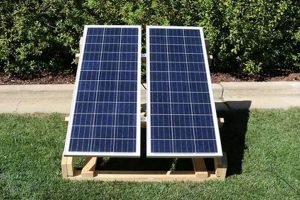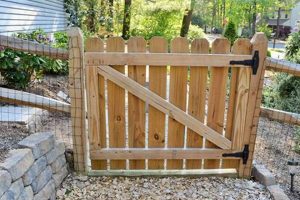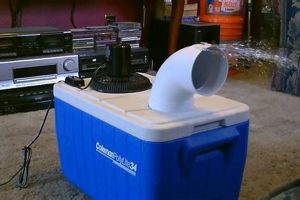The process of creating independent air circulation systems for enclosed resin-based additive manufacturing equipment addresses the need to mitigate the release of volatile organic compounds (VOCs) into the immediate environment. These setups are typically constructed from readily available components, such as ducting, fans, and filtration media, with the objective of capturing and expelling or neutralizing airborne contaminants produced during printing. A common example involves using a flexible hose to vent fumes from an enclosure directly to an exterior window, coupled with a fan to create negative pressure within the enclosure.
Such customized ventilation systems are important due to potential health concerns associated with prolonged exposure to VOCs emitted by resin printing processes. Implementing effective fume extraction contributes to a safer working environment, reducing the risk of respiratory irritation, headaches, and other adverse health effects. Historically, the development of these solutions has been driven by both the increasing affordability and accessibility of resin printers for hobbyists and small businesses, and a concurrent awareness of the need for adequate safety precautions to complement their usage.
The following sections will detail the various design considerations for constructing a customized air circulation system, including fan selection, filtration methods, enclosure design, and considerations for regulatory compliance and safe disposal of waste materials generated by the process.
Essential Considerations for Customized Air Circulation Systems
The following guidelines are intended to assist in the effective design and implementation of independent air circulation solutions for resin-based additive manufacturing.
Tip 1: Enclosure Integrity: Prioritize a sealed enclosure to contain fumes. Evaluate all seams and access points for potential leaks and address them with appropriate sealing materials.
Tip 2: Negative Pressure: Ensure the exhaust fan generates negative pressure within the enclosure. This prevents fumes from escaping into the surrounding environment when the enclosure is opened.
Tip 3: Adequate Airflow: Select a fan with sufficient cubic feet per minute (CFM) rating to effectively evacuate fumes from the enclosure. Calculate CFM based on the enclosure volume and desired air exchange rate.
Tip 4: Filtration Integration: Incorporate appropriate filtration media, such as activated carbon filters, to capture VOCs. Replace filters regularly according to manufacturer specifications or based on observed performance degradation.
Tip 5: Exhaust Ducting: Utilize rigid or semi-rigid ducting for fume extraction to minimize leaks and ensure consistent airflow. Avoid sharp bends that can impede airflow.
Tip 6: Exhaust Location: Vent exhaust to a safe location, ideally outdoors, away from windows, doors, and air intakes. Ensure compliance with local regulations regarding exhaust emissions.
Tip 7: Monitoring and Maintenance: Regularly inspect the ventilation system for leaks, blockages, and fan performance. Document maintenance activities and track filter replacement schedules.
Tip 8: Safety Equipment: Employ personal protective equipment (PPE) at all times, including respirators and gloves, when handling uncured resin and servicing the ventilation system.
Adhering to these guidelines will contribute to a safer and more controlled environment for resin-based additive manufacturing, mitigating potential health risks associated with VOC exposure.
The subsequent sections will address more advanced topics such as advanced filtration techniques and integration with air quality monitoring systems.
1. Enclosure airtightness
Enclosure airtightness represents a foundational element in the effective implementation of independently constructed air circulation systems for resin printers. The primary function of these systems is to capture and remove volatile organic compounds (VOCs) released during the printing process, thereby minimizing operator exposure and environmental contamination. The integrity of the enclosure directly impacts the efficiency of this contaminant removal. A poorly sealed enclosure permits the uncontrolled escape of VOCs into the surrounding environment, negating the intended benefits of the ventilation system and posing a potential health hazard. Conversely, a well-sealed enclosure allows the ventilation system to establish and maintain negative pressure, drawing all fumes through the designated filtration and exhaust pathways.
The relationship between enclosure airtightness and system performance is analogous to the effect of leaks in a vacuum system. A vacuum pump can only achieve its designed level of vacuum if the system it is connected to is properly sealed. Similarly, an exhaust fan connected to a resin printer enclosure can only effectively remove VOCs if the enclosure is airtight. Examples of compromised airtightness include gaps around doors or access panels, unsealed joints in the enclosure construction, and penetrations for wiring or tubing that are not properly sealed. Addressing these deficiencies often involves the application of weather stripping, sealant, or gasketing materials.
In summary, enclosure airtightness is not merely a desirable feature, but a critical prerequisite for the successful operation of any independently built air circulation system designed to mitigate VOC emissions from resin printers. Achieving and maintaining a leak-free enclosure is essential for ensuring operator safety, regulatory compliance, and the overall effectiveness of the contaminant control strategy. Without adequate airtightness, the potential benefits of filtration and exhaust mechanisms are substantially diminished, rendering the system largely ineffective.
2. Airflow optimization
Airflow optimization is integral to the effective operation of independently constructed air circulation systems for resin printers. The efficiency with which these systems capture and remove volatile organic compounds (VOCs) is directly proportional to the proper management of air movement within and around the printing enclosure.
- Fan Selection and Placement
Appropriate fan selection is paramount. The fan must possess sufficient cubic feet per minute (CFM) capacity to evacuate the enclosure volume within a reasonable timeframe. Fan placement within the system is equally critical. Typically, an exhaust fan is positioned to draw air from the lowest point in the enclosure, where heavier VOCs tend to accumulate. Conversely, an intake vent, if used, should be positioned to facilitate a consistent and uniform airflow pattern throughout the enclosure. Inadequate fan selection or improper placement can lead to stagnant air pockets and reduced VOC cap
ture efficiency. - Ducting Design and Implementation
The design and implementation of ducting systems significantly impact airflow. Sharp bends and constrictions increase static pressure, impeding airflow and reducing the overall effectiveness of the system. Ducting should be selected with an internal diameter sufficient to accommodate the fan’s CFM rating without undue restriction. Smooth-walled ducting minimizes frictional losses compared to corrugated or flexible ducting. The length of the duct run should also be minimized to reduce static pressure losses and maintain optimal airflow.
- Enclosure Venting and Pressure Management
Effective airflow optimization necessitates careful consideration of enclosure venting and pressure management. Creating a slight negative pressure within the enclosure prevents the escape of VOCs into the surrounding environment. This is typically achieved by ensuring the exhaust fan’s capacity exceeds the combined area of all enclosure openings, including intentional vents and unintentional leaks. Conversely, excessive negative pressure can impede the printer’s operation or introduce contaminants from the surrounding environment. Achieving a balanced pressure differential is essential for optimal performance.
- Filter Media Resistance
The selection of filter media directly impacts airflow. High-efficiency particulate air (HEPA) filters and activated carbon filters, while effective at removing VOCs and particulates, introduce resistance to airflow. The fan selected for the system must be capable of overcoming this resistance to maintain adequate airflow. Overly restrictive filter media can significantly reduce the system’s overall efficiency. It is essential to balance filtration effectiveness with airflow considerations to achieve optimal performance.
The interrelation of these components directly impacts the efficacy of air circulation for resin printers. Optimal airflow ensures contaminants are captured, filtered, and exhausted effectively, minimizing potential health risks and environmental impact.
3. Filtration effectiveness
Filtration effectiveness is a critical determinant of the overall performance of independently constructed air circulation systems intended for use with resin printers. The capacity of these systems to mitigate the release of volatile organic compounds (VOCs) and particulate matter into the surrounding environment depends significantly on the efficiency of the filtration mechanisms employed.
- Selection of Filtration Media
The choice of filtration media dictates the types and quantities of contaminants removed from the airstream. Activated carbon filters, for example, are commonly used to adsorb VOCs, while high-efficiency particulate air (HEPA) filters are designed to capture particulate matter down to a specific micron size. The selection of the appropriate media must align with the specific types of contaminants generated by the resin printing process. For instance, certain resins may release specific VOCs that require specialized activated carbon formulations for effective removal. Improper media selection undermines the entire ventilation strategy.
- Filter Surface Area and Contact Time
The surface area of the filter and the duration of contact between the contaminated airstream and the filtration media directly influence the efficiency of contaminant removal. Larger filter surface areas provide more sites for adsorption or capture, increasing the filter’s capacity and lifespan. Similarly, longer contact times, achieved through reduced airflow or optimized filter geometry, allow for more complete interaction between the contaminants and the filtration media. Insufficient surface area or contact time can lead to incomplete contaminant removal and reduced air quality.
- Filter Maintenance and Replacement
The long-term effectiveness of any filtration system depends on diligent maintenance and timely replacement of filter media. Over time, filters become saturated with contaminants, reducing their capacity and efficiency. Regular inspection and replacement of filters, according to manufacturer recommendations or based on observed performance degradation, are essential for maintaining optimal air quality. Neglecting filter maintenance can lead to a buildup of contaminants within the system and a subsequent decrease in air quality.
- Sealing and Bypass Prevention
Even the most effective filtration media is rendered useless if the filtration system is not properly sealed to prevent bypass. Air leaks around the filter housing or ducting allow contaminated air to circumvent the filter, negating its intended function. Careful attention to sealing all joints and connections is essential for ensuring that all air passes through the filtration media. The use of appropriate sealing materials and regular inspection for leaks are critical for maintaining filtration effectiveness.
The successful application of independent air circulation systems for resin printers hinges on a comprehensive understanding of filtration effectiveness and its determinants. Optimizing filter selection, surface area, maintenance, and sealing are essential for achieving effective contaminant removal and creating a safer operating environment. Ignoring these critical factors can compromise the entire ventilation strategy, posing potential health risks and environmental hazards.
4. Safe exhaust
The safe discharge of contaminated air is a paramount consideration in the design and implementation of independently constructed ventilation systems for resin-based additive manufacturing equipment. An improperly managed exhaust stream presents potential risks to both the immediate operating environment and the wider surrounding area.
- Exhaust Location Selection
Determining the appropriate location for exhaust discharge necessitates careful evaluation of prevailing wind patterns, proximity to building air intakes, and adherence to local regulations. Exhaust should be directed away from windows, doors, and air conditioning units to prevent re-entry of contaminants into occupied spaces. Ideal exhaust locations are typically high above ground level and far from pedestrian traffic. Failure to consider these factors can result in the recirculation of harmful VOCs, negating the benefits of the ventilation system.
- Ducting Material and Integrity
The selection of appropriate ducting materials is crucial for maintaining the integrity of the exhaust stream. Ducting must be resistant to corrosion, chemical degradation, and temperature fluctuations. Rigid or semi-rigid ducting is generally preferred over flexible options due to its superior durability and reduced risk of leaks. All ducting connections must be properly sealed to prevent the escape of contaminated air. Compromised ducting can release VOCs into unintended areas, compromising air quality and posing health hazards.
- Filtration Before Exhaust
While the primary function of the exhaust system is to remove contaminated air from the printing enclosure, it is often advisable to incorporate secondary filtration mechanisms prior to discharge. This may involve the use of additional activated carbon filters or other specialized media to further reduce VOC
concentrations in the exhaust stream. This approach minimizes the potential for environmental contamination and ensures compliance with stringent air quality standards. Neglecting pre-exhaust filtration can result in the release of significant quantities of harmful substances into the environment. - Compliance with Regulations
Local, state, and federal regulations often govern the permissible levels of VOC emissions. Independent ventilation systems must be designed and operated in compliance with all applicable regulations. This may involve conducting air quality testing to verify emission levels and obtaining permits from relevant authorities. Failure to comply with these regulations can result in significant fines and legal penalties. Thoroughly researching and adhering to all applicable regulations is essential for the responsible operation of an independent ventilation system.
The implementation of a safe and effective exhaust strategy is an indispensable component of any independently constructed ventilation system for resin printers. Proper exhaust location, robust ducting materials, pre-exhaust filtration, and regulatory compliance are all essential elements in mitigating the potential risks associated with VOC emissions. A failure to adequately address these considerations can compromise the health and safety of operators and the surrounding environment.
5. Consistent maintenance
Effective independent air circulation systems, frequently assembled for resin-based 3D printers, are intrinsically reliant on consistent maintenance. The absence of a structured maintenance program directly undermines the system’s capacity to mitigate operator exposure to volatile organic compounds (VOCs) and particulate matter. As a direct consequence, performance degrades, potentially leading to increased concentrations of hazardous substances in the immediate working environment. A real-world example includes the progressive clogging of activated carbon filters, diminishing their VOC adsorption capacity over time. Without regular filter replacement, the system’s exhaust stream releases increasing amounts of unfiltered contaminants. Therefore, recognizing the need for consistent maintenance is not simply a best practice, but a critical component of any independently constructed ventilation system’s design and operational protocols. This understanding is of paramount practical significance in preserving operator safety and ensuring the system operates within acceptable air quality parameters.
Further analysis reveals that consistent maintenance encompasses a range of activities beyond filter replacement. Ductwork inspections are essential to identify and rectify leaks or blockages that impede airflow. Fan performance must be periodically evaluated to confirm the system maintains adequate negative pressure within the printing enclosure. The integrity of enclosure seals should be verified to prevent uncontrolled VOC escape. Documenting all maintenance activities provides a record of system performance and facilitates proactive intervention. For example, documenting filter replacement dates allows for accurate scheduling of future replacements based on observed filter saturation rates. This proactive approach minimizes the risk of system failure and ensures consistent air quality control. Practical application involves implementing a checklist-based maintenance schedule and training personnel in proper inspection and maintenance procedures.
In summary, the efficacy of air circulation systems is inextricably linked to consistent maintenance protocols. Neglecting routine inspections, filter replacements, and ductwork assessments leads to a degradation of system performance and an increased risk of operator exposure to hazardous substances. The challenges associated with maintaining these systems, such as the cost of replacement filters and the time required for inspections, are outweighed by the benefits of improved air quality and enhanced operator safety. Consistent maintenance should therefore be viewed as an integral part of the overall air quality management strategy for resin-based additive manufacturing, ensuring long-term system performance and compliance with relevant safety standards.
Frequently Asked Questions
The following questions and answers address common concerns and misconceptions regarding the construction and operation of independent air circulation systems for resin-based additive manufacturing equipment. The information provided aims to enhance understanding and promote safe and effective ventilation practices.
Question 1: Is independent ventilation truly necessary for resin printing?
The necessity of independent ventilation is contingent upon several factors, including the type of resin utilized, the size and configuration of the printing environment, and the sensitivity of individuals to volatile organic compounds (VOCs). While some may perceive the odor from resin printing as merely unpleasant, many resins emit harmful VOCs that can pose a risk to respiratory health and overall well-being. Therefore, implementation of proper ventilation is strongly advised, especially in poorly ventilated areas or where individuals are particularly susceptible to respiratory irritation. Failure to provide adequate ventilation may result in long-term health consequences.
Question 2: What are the essential components of a DIY air circulation system for resin printers?
The core components typically include an enclosure to contain fumes, an exhaust fan with sufficient cubic feet per minute (CFM) rating, ducting to direct airflow, and filtration media to remove VOCs and particulate matter. The enclosure should be airtight to prevent fumes from escaping into the surrounding environment. The exhaust fan should be selected based on the enclosure volume and desired air exchange rate. Ducting should be smooth-walled and as short as possible to minimize airflow resistance. Activated carbon filters are commonly used to adsorb VOCs, while HEPA filters are used to capture particulate matter.
Question 3: What type of filtration is most effective for resin printing VOCs?
Activated carbon filtration is generally considered the most effective method for removing VOCs emitted during resin printing. Activated carbon possesses a high surface area and is capable of adsorbing a wide range of organic compounds. However, the specific type of activated carbon may influence its effectiveness for certain VOCs. It is advisable to select activated carbon filters specifically designed for use with resin printing or those that demonstrate broad-spectrum VOC removal capabilities. Additionally, regular filter replacement is crucial for maintaining optimal performance.
Question 4: How can negative pressure within the enclosure be effectively established and maintained?
Establishing and maintaining negative pressure involves ensuring the exhaust fan removes air from the enclosure at a rate slightly greater than the rate at which air enters the enclosure through leaks or intentional vents. This can be achieved by selecting an exhaust fan with sufficient CFM capacity and minimizing leaks in the enclosure. Sealing all seams and access points with appropriate materials is essential. The use of an adjustable fan speed controller allows for fine-tuning of the airflow to achieve the desired negative pressure without unduly stressing the fan or causing excessive noise.
Question 5: What are the key safety precautions to observe when constructing and operating a DIY ventilation system?
Prior to construction, it is essential t
o review the safety data sheets (SDS) for all resins being utilized to understand the potential hazards and recommended safety measures. Personal protective equipment (PPE), including respirators and gloves, should be worn when handling uncured resin and servicing the ventilation system. The exhaust stream should be vented to a safe location, away from windows, doors, and air intakes. Regularly inspect the system for leaks and blockages. Ensure all electrical connections are properly grounded and comply with local electrical codes. Dispose of used filters and resin waste in accordance with local regulations.
Question 6: How often should the filters in a DIY ventilation system be replaced?
Filter replacement frequency depends on several factors, including the type of resin used, the frequency of printing, and the effectiveness of the enclosure and ventilation system. A general guideline is to replace activated carbon filters every 1-3 months and HEPA filters every 3-6 months. However, it is advisable to monitor the odor level emanating from the exhaust stream. A noticeable increase in odor indicates filter saturation and the need for replacement. Documenting filter replacement dates and observing system performance over time will allow for more accurate scheduling of future replacements.
In conclusion, independent ventilation systems offer a means of mitigating the risks associated with resin printing. However, successful implementation requires a thorough understanding of the principles of airflow management, filtration technology, and safety practices. Furthermore, consistent maintenance is essential for ensuring long-term system performance and protecting the health of operators.
The subsequent sections will address topics such as regulatory considerations and advanced system design options.
diy ventilation for resin printer
The preceding exploration of independent air circulation systems for resin printers underscores the importance of a multifaceted approach to contaminant control. Effective implementation necessitates careful consideration of enclosure integrity, airflow optimization, filtration effectiveness, safe exhaust practices, and consistent maintenance protocols. The interaction of these elements determines the degree to which these systems mitigate the risks associated with volatile organic compound (VOC) exposure during resin-based additive manufacturing.
Given the potential health implications associated with prolonged VOC exposure, a proactive approach to air quality management is paramount. Implementing a thoughtfully designed and diligently maintained “diy ventilation for resin printer” strategy represents a responsible commitment to operator safety and environmental stewardship. Further research and adherence to best practices are strongly encouraged to ensure the continued effectiveness and safety of these systems in the evolving landscape of resin-based additive manufacturing.







